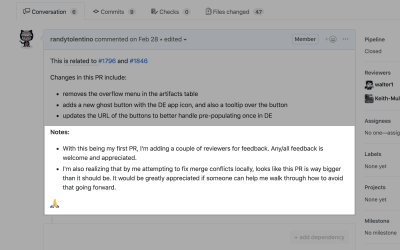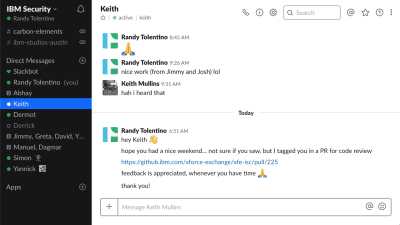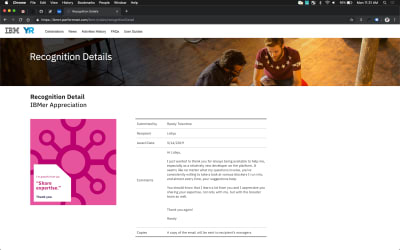
Creating Authentic Human Connections Within A Remote Team
Creating Authentic Human Connections Within A Remote Team
Randy Tolentino
On any given day, walk into your local coffee shop and you’ll likely see someone situated at a table, staring into a computer screen. Without knowing any details, one thing’s for sure, it’s obvious they’re ‘at work’. Many of us have been there at some point in our careers—all we need is a power outlet, internet access, and we’re good to go.
As a software developer for a global company, I have the benefit of collaborating with people from all over the world. Here, from the IBM Design Studio in Austin, Texas, approximately 4,500 miles and at least a fifteen-hour flight separate myself from the nearest developers on our product team. If we consider the furthest members, try 18 hours away by plane, literally on the other side of the planet.
In this current role, I’m a part of a multi-site team where most of the technical people are based out of two primary locations: Cork, Ireland and Kassel, Germany. On this product team, I happen to be the only satellite developer based in Austin, although I do have the benefit of sitting alongside our design team.
Scenarios like these are common nowadays. In 2018, Owl Labs found that 56% of the participating companies in their study adopted or allowed for some form of remote arrangement for its employees. While this organizational approach has revolutionized the way we perform our job functions, it’s also paved the way for new patterns to emerge in the way we interact with each other across the distance.

Connecting With People
I’ve always found that the most fascinating aspect of a distributed team is its people. The ‘diversity of people’, in itself, deserves emphasis. In my view, this mix of skills, knowledge, and perspectives make up the heart of the experience. Being able to integrate with people from various backgrounds is eye-opening. Hearing different accents, discovering new ways to look at problems, and learning about world cultures all within the normal flow of the day is simply refreshing.
At the same time, one of the biggest hurdles for those on remote teams is forming a relationship with your colleagues, that genuine human connection. In a 2018 study by And Co and Remote Year, 30% of the respondents reported lack of community as the number one factor impacting their happiness at work, understandably so. Having virtual colleagues makes it easy to fall into the trap of thinking ‘we all have individual assignments, we only need to interact when our work crosses paths, and all we’re here to do is deliver’.
It’s just not enough.
Throughout my career, almost every project I’ve worked on involved others that were remote in some capacity. In this context, I’ve learned plenty about what it takes to build meaningful partnerships with people across varying distances and multiple time zones. My hope is that the following list of suggestions and ideas can help others out there who are navigating through the challenge of building actual human connections with their teammates.
- People, Not Resources
- Building A Continuous Improvement Culture
- Reading Emotions Across The Distance
- A Little Extra Effort Can Bridge The Gap
- Staying Thankful At The Core
1. People, Not Resources
Problem: Sometimes, remote team members can be mistakenly reduced or perceived as ‘contributors only’. In some cases, people are actually referred to as ‘resources’, literally.
About a year ago, I was on a kick-off call for a project where the client was headquartered in another city. At one point during the virtual meeting, I politely asked one of the client-stakeholders about credentials and ownership of a third-party app that they used. It was a fair question, I was simply gathering requirements. But his response towards me was belittling and unprofessional, making it seem as if I were questioning his knowledge or authority. From then on, it’s been a personal goal of mine to always acknowledge remote colleagues as people, not just resources.
At the very minimum, great collaborations are comprised of individuals who respect and care about one another on a holistic level. Sure, we collectively share the same objectives, but we’re also more than just workers. The very idea of ‘having a genuine connection with people you work with’, is a proven motivator for many when it comes to job satisfaction. It makes sense because as human beings, we have an innate need to connect with one another—this is especially true on remote teams.
These are some ways to remind us that people are the foundation of your team:
- Proactively introduce yourself to as many teammates as possible.
- Learn about each other, share cultures, stories, and professional backgrounds.
- Be mindful of your audible and legible tone (on calls and chats), keep it friendly and respectful.
2. Building A Continuous Improvement Culture
Problem: As remote team members, we can find ourselves stranded on an island if we don’t ask for help sooner than later.
Oftentimes, we make the mistake of believing that in order to bring value to the team, we must know everything (all the time). This ‘rugged individualist’ mentality is a one-way ticket to imposter syndrome. The next thing you know, a significant amount of time passes, your progress remains stagnant, and by the time someone extends a hand you’re already underwater. Remember, no one knows everything, and more importantly, teams thrive off of collaboration. We learn together.
The best functioning teams that I’ve been on all had a healthy continuous learning culture. On these teams, failure is okay, especially when our mistakes are transformed into learning opportunities. When working on a remote team, instead of running or hiding from our mistakes, I personally recommend that we fail in “public”. This lets the team know that you hired a human, one who’ll run into stumbling blocks and will inevitably produce errors. By doing so, this gives others the opportunity to either offer assistance, or learn.

You can contribute to the team’s improvement culture in the following ways:
- Leverage public channels to show when you’re stuck, this allows the group to help or point you in the right direction.
- Share what you’ve learned in public channels, retrospectives, or through documentation.
- Spend time listening and scanning for ways to help others.
- When you do help your team, remind them that everyone asks for help and how you are all on this journey together.
3. Reading Emotions Across The Distance
Problem: Understanding someone’s emotional state is already difficult when you’re in the same office. When it comes to communicating online, getting a good read on someone’s tone, feelings, or intent, becomes even more challenging.
In person, it’s relatively easier to exercise soft-skills because you’re in the same physical space as your colleagues. From laughter to frustration, there’s an advantage we gain from being co-located when it comes to interpreting how someone is feeling. We can gauge these emotions based off of vocal inflections, facial expressions, and gestures.
However, when we’re far from teammates, we have to be more creative when trying to convey or pick-up on these sentiments. When I breakdown how I communicate with my team throughout the day, about 90% of it occurs in chats; the remaining 10% is split between in conference calls, email, and any other tool that allows for commenting. In each of these modes, we have to clearly convey not only what we say, but what we mean and how we feel.

We can improve our team’s collective ability to read and convey emotions in the following ways:
- Video calls provide a visual and audible opportunity to pick up on our expressions; turn on the camera and smile at each other.
- Instead of just focusing on business objectives, develop the habit of paying particular attention to tone and feelings when communicating with your team.
- Use the appropriate emoji to supplement your thoughts or reactions; these fun and effective special characters can help to surface your feelings.
4. A Little Extra Effort Can Bridge The Gap
Problem: The physical mileage between team members and multiple time-zones can cause a strain in our effort to connect with our colleagues.
With Germany being 7 hours ahead and Ireland being 6, I am constantly reminded how the time difference is an issue. On most occasions, when I have questions or run into some sort of blocker anytime after lunch, all of our dev team is offline.
If I worked the typical 9-to-5 schedule, I’d only have about 3 to 4 hours of an overlap with my remote team. It took me a few weeks to fully realize how much the time difference was a factor, but once I did, I decided to flex my schedule.
When I learned that our Ireland team had daily standups at 10:30 AM, (4:30 AM our time), I asked to be invited to those meetings. Most people might think: that’s way too early! But, for a couple of weeks, I joined their call and found it to be incredibly helpful from an alignment and tracking perspective. More importantly, the team understood that I was here to be as helpful as possible and was willing to sacrifice my own conveniences for the sake of the team.
While we can’t do much about the distance, there are a few strategies to potentially improving the overlap:
- Find creative ways to extend yourself for the interest of the team; these gestures show good faith and the willingness to make things better for the group.
- Be equally accommodating towards others and reciprocate the flexibility your colleagues show towards one another.
- Take the most advantage of the overlapping time, ask critical questions, and ensure no one is blocked from making progress.
5. Staying Thankful At The Core
Problem: In our work, we spend almost every minute of every day focusing our attention on solving some sort of problem.
Deeply embedded into my personal culture is an appreciation mindset; practicing gratitude allows me to maintain a fairly good mood throughout the day. I regularly think about how blessed I am to work in the tech industry, helping to solve some of the world’s most challenging problems. I can never take this for granted. Being able to listen to my favorite hip hop playlists, writing code all day, and having access to learning from a wealth of individuals, this is a dream come true. This thankful mentality stays with me no matter what and it’s something I aim to emit when interacting with my team.
It’s not always easy though. In the tech industry, we spend nearly every minute of the day, using our skills and creativity to find our way out of a problem. Sometimes we’re focused on business problems, maybe we’re solving a user pain point, or maybe we’re managing an internal team issue. This repetition, over time, this can take a toll on us, and we could forget why we even chose to do this.
Keeping a positive attitude can help lift team morale and has been known to make you a better collaborator. Even though you may be far from your teammates, your attitude comes through in your work and communications. Here are some pointers to keep in mind when showing appreciation towards your team:
- Use company tools to acknowledge a teammate.
- Ask teammates how they’d like to be recognized, and thank them accordingly.
- Relay positive feedback to a colleague’s lead or manager.

Remember To Be Human
You see them on various social media platforms, posts or photos of a team retreat where employees step away from their projects for a few days to focus on team-building. Some organizations intentionally design these events into their annual schedules; it’s an excellent way to bridge the gaps and facilitate bonding. Many teams return home from these retreats and experience improved alignment and productivity.
For other organizations, having the ability to meet face-to-face with your remote counterparts isn’t an option. In these cases, we have to make the best of our circumstances by depending on our soft-skills and creativity to help form the alliances we need. I’m confident that by caring for one another as people first, we collectively become better at what we do.
Behind every @username, profile picture, and direct message is a person, one who probably cries and rejoices for the same reasons you might. As technology continues to influence new social behaviors that shape the way we work, it’s important to remember that phenomenal teams are composed of individuals who understand each other and care for one another.
People make products, it’s not the other way around. No matter how far the distance between you and your teammates, I encourage you to make a conscious effort to connect with one another, invest in long-lasting friendships, and last but not least, remember to be human.
🙏
 (ra, il)
(ra, il)
Articles on Smashing Magazine — For Web Designers And Developers
